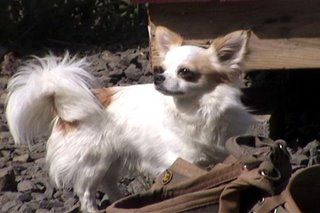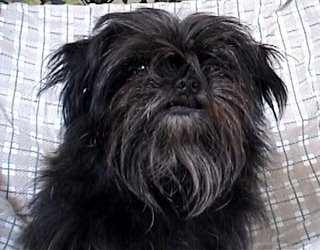
A Little Bit about the Chihuahua
by Connie Limon (Email:
connielimon@yahoo.com)
The Chihuahua is know by no other name and has been popular north and south of the Rio Grande for many years. It is the oldest purebred canine native to the North American continent.
The Chihuahua's origin is filled with tales and extends back to the Toltec civilization of Mexico in the ninth century. Discovery of the earliest Chihuahuas were in the state of Chihuahua, Mexico. Ancestors of the Chihuahua could include a small hairless Chinese dog, which could account for the size reduction of the original Chihuahua. The ancient people in Mexico first developed a prairie dog or gopher, which was mute, longhaired and larger than the present-day Chihuahua. Tales are many about the uses of this tiny dog in Toltec and later Aztec religious rites. Nearly all Chihuahua fanciers accept one fact: This is that the modern Chihuahua that was discovered in Chihuahua, Mexico, in the mid-1800s stands apart from all other canines. This tiny breed prefers its own kind to all other dogs.
The Chihuahua can be sociable with other dogs, but most definitely still is more content when surrounded by other Chihuahuas. Because of this fact it probably is not a good idea to own other pets if you desire to own a Chihuahua. Your household will be better of with multiple Chihuahuas if that is your chosen breed. The Chihuahua has no claims of ties to royalty and any hunting abilities or heritage.
The Chihuahua is known primarily as a wonderful little social able human companion and that is the main purpose of the Chihuahua today and in time past. The Chihuahua is quite content to have no work assigned to it. He fits nicely even in the smallest spaces and is content to spend his days lying in the sun or being pampered by its humans. The Chihuahua makes a perfect pocket pal and can travel with you just about anywhere almost invisible to strangers. The Chihuahua is not a big eater; therefore, food expense for the Chihuahua is quite minimal. He actually requires no kind of special care beyond a warm place to sleep and his treasured humans.
Chihuahua is usually most comfortable with senior adults and other adult families. They do not fit well into homes with preschoolers, toddlers or young adolescents. Preschoolers may try to grab at the Chihuahua, toddlers are likely to step on it or fall over it and young adolescents in their busy rush of a day may injure it. Personality The Chihuahua will usually claim ownership of one family member with whom it bonds tightly. He is brave, loyal, affectionate and intelligent that can be highly sensitive and stubborn. He does not do well walking on a leash and being taken for long walks. It is just easier to pick up the Chihuahua and carry him on your walk rather than have him in a collar and on a leash. They are mostly house companions and adornments. Some are able to learn tricks and may even enjoy performing for guests.
Appearance
The Chihuahua has no height standard but usually stands about 5 inches tall and weighs no more than 6 pounds. Its skull is described as an apple dome shape, with or without a spot spot. Its muzzle is short and pointed. The Chihuahua is shown in smooth- and longhaired varieties. The smooth variety's coat should be soft, glossy and close. The longhaired variety coat has a soft texture withor without waves or curls, its ears are edged with fringes, and its tail, feet, legs and neck are well feathered. Colors are any color or combination of colrs, solid, marked, or splashed.
Grooming
You will need a cushioned bristle brush and a medium-toothed comb for both the smooth coat and long haired varieties. The long haired Chihuahua is easy to maintain with weekly brushing. The short haired coat also benefits from weekly brushings. You can use a chamois cloth to bring the coat up to a shine in the short haired Chihuhua.
Author: Connie Limon. Visit us at
http://www.abouttoydogs.com/ and sign up for our newsletters. About Toy Dogs is a guide to the selection and care of toy dog breeds. We feature articles, dog training resources, dog books, dog supplies and a toy dog breed directory. Purchase a full page ad with up to 3 pictures, a 12 picture video and advertising in our newsletters for one year at the rate of $25 per year.
This article is FREE to publish with the resource bo
 Photo courtesy of http://www.badgercrest.com
Photo courtesy of http://www.badgercrest.com








